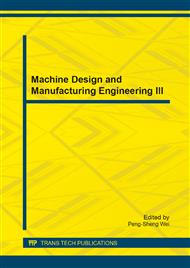[1]
Zhang Guobing, Zhang wenliang, Shock acceleration restriction and safety margin estimation for UHV transformer transportation, High Voltage Engineering , Vol. 36, No. 1, Jan. 31, 2010, pp.290-295.
Google Scholar
[2]
Li Gang, Chen Changhong, Zhang Yusheng, Yang Xinmin, Wang Wei, Analysis on the static and dynamic strength of cyclone dust collector, China Safety Science Journal, Vol. 9, No. 3, Jun . 1999, pp.59-64.
Google Scholar
[3]
Huang Song-gao, Discull of evaluation technology in the safety margin of system level electromagnetic compatibility, Safety & EMC, 2001, pp.28-31.
Google Scholar
[4]
Yu Shu-rong, Fuzzy assessment of pressure vessels safety based on the failure assessment diagram, Journal of Gansu University of Technology, Vol. 22 No. 2, Jun. 1996, pp.43-47.
Google Scholar
[5]
Zhou Lian-dong, Jiang Nan, Analysis of the ASME constitutive mode with strain effect and safety margin for pressure vessels, Pressure vessel Technology, Vol. 28, No. 6 2011: pp.11-15, 23.
Google Scholar
[6]
Shi Qiuhong, Song Tianmin, Zhang Guofu, Shi Yu, Liu Xing-quan, Zhao Na, Analyse and assess the visbreaking reactor's safety margin and safe service life, Machinery Design &Manufacture, No. 9, Sep. 2007, pp.215-217.
Google Scholar
[7]
Jiang Nan, Chen Guoxuan, Li Zhaofeng, Effects of strain hardening on safety margin of pressure vessels, Journal of South China University of Technology (Nature Science Edition), Vol. 40, No. 11, November 2012, pp.89-93.
Google Scholar
[8]
Mahendra Prasad, R. S Rao, S. K Gupta, Assessment methodology for confidence in safety margin for large break loss of coolant accident sequences, Annals of Nuclear Energy 38(2011), pp.1225-1230.
DOI: 10.1016/j.anucene.2011.02.015
Google Scholar
[9]
Tao-Ho Woo, Un-Chul Lee, Safety assessment for the passive system of the nuclear power plants(NPPs) using safety margin estimation, Energy 35(2010), pp.1799-1804.
DOI: 10.1016/j.energy.2009.12.034
Google Scholar
[10]
Tao-Ho Woo, Un-Chul Lee, The statistical analysis of the passive system reliability in the Nuclear Power Plants(NPPs), Progress in Nuclear Energy 52(2010), pp.456-461.
DOI: 10.1016/j.pnucene.2009.10.001
Google Scholar
[11]
Paris P., Erdogan F., A critical analysis of crack growth laws, Journal of basic engineering, Transaction of the ASME, 1963(85), pp.528-534.
DOI: 10.1115/1.3656902
Google Scholar


